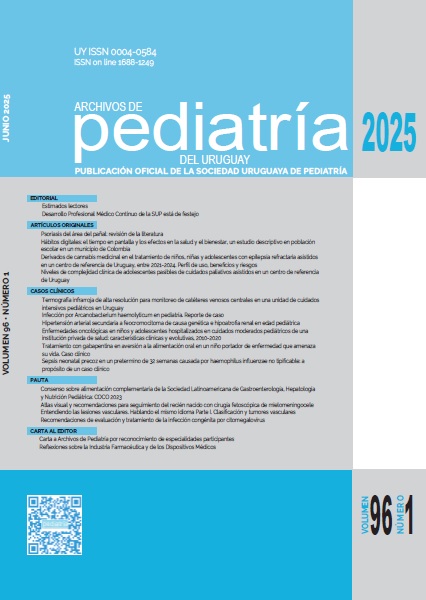Abstract
Introduction: oncological diseases are rare in pediatric patients but they cause significant morbidity and mortality. They manifest with non-specific symptoms, which facilitates diagnostic delay.
Objective: understand clinical and evolutionary characteristics of children /adolescents hospitalized for oncological pathologies in a private health provider between 2010 and 2020.
Methodology: Retrospective descriptive cohort study, including children under 18 years of age hospitalized for oncological diseases between 01/01/2010 and 12/31/2020. Their medical records were reviewed. The following were described: epidemiological, clinical and evolutionary characteristics.
Results: during the evaluated time, 61 patients were hospitalized: 39 with solid tumors, 22 hematological. The incidence was 14/100,000, with an average of 5 cases/year. The average age at diagnosis was 5.9 years, 59% were under 5 years old. The most common types of cancer were: leukemia and neuroblastoma. The most frequent manifestations in hematological tumors were: fever and nonspecific symptoms; in solid tumors those linked to location. In 35 children the diagnosis was made in less than 30 days. Forty-seven patients received chemotherapy, of which 34 presented febrile neutropenia. 33 patients were cured, 2 remain in remission, 10 relapsed, and 16 died.
Conclusions: the incidence of oncological diseases in the period analyzed was similar to that reported in the whole country. The most common type was leukemia. It predominated in children under 5 years of age. More than half were cured, a quarter of the patients died, results similar to those in higher-income countries. These results allow us to improve the care provided to these patients and their families.
References
Pan American Health Organization. Early diagnosis of childhood cancer. Washington, DC: PAHO, 2014. Disponible en: https://iris.paho.org/handle/10665.2/34850. (Consulta: 29 mayo 2021).
Quilty R. Mind the gap: improving pediatric cancer care in developing countries. Univ Ott J Med 2016; 6(2):40-2. doi:10.18192/uojm.v6i2.1812.
Howlader N, Noone A, Krapcho M, Miller D, Brest A, Yu M, et al. SEER Cancer Statistics Review, 1975-2017. Bethesda, MD: National Cancer Institute, 2020. Disponible en: https://seer.cancer.gov/csr/1975_2017/. (Consulta: 29 mayo 2021).
Castillo L, Fluchel M, Dabezies A, Pieri D, Brockhorst N, Barr R. Childhood cancer in Uruguay: 1992-1994. Incidence and mortality. Med Pediatr Oncol 2001; 37(4):400-4. doi: 10.1002/mpo.1217.
Dufort y Álvarez G. Epidemiología del cáncer en niños y adolescentes en Uruguay: 2008- 2012: un estudio de registro poblacional. Arch Pediatr Urug 2021; 92(1):e202. doi: 10.31134/ap.92.1.3.
Acha T. Diagnóstico precoz y signos de alarma en oncohematología pediátrica. En: Asociación Española de Pediatría de Atención Primaria. Curso de actualización pediatría 2015. Madrid: Lúa-ediciones 3.0, 2015:177-86.
Ahrensberg J, Hansen R, Olesen F, Schrøder H, Vedsted P. Presenting symptoms of children with cancer: a primary-care population-based study. Br J Gen Pract 2012; 62(600):e458-65. doi: 10.3399/bjgp12X652319.
Dang T, Franco E. Diagnosis delays in childhood cancer: a review. Cancer 2007; 110(4):703-13. doi: 10.1002/cncr.22849.
Steliarova E, Stiller C, Lacour B, Kaatsch P. International Classification of Childhood Cancer, third edition. Cancer 2005; 103(7):1457-67. doi: 10.1002/cncr.20910.
Fritz A, Percy C, Jack A, Kanagaratnam S, Sobin L, Parkin D, et al, eds. Clasificación Internacional de Enfermedades para Oncología CIE-O. 3 ed. Washington, DC: OPS, 2003:242-5.
Lam C, Howard S, Bouffet E, Pritchard K. Science and health for all children with cancer. Science 2019; 363(6432):1182-6. doi: 10.1126/science.aaw4892.
Fernández S, Reques B. Tratamiento del Cáncer en Pediatría: principios de la terapia multimodal. Pediatr Integral 2012; 16(7):540-51.
Ohlsen T, Martos M, Hawkins D. Recent advances in the treatment of childhood cancers. Curr Opin Pediatr 2024; 36(1):57-63. doi: 10.1097/MOP.0000000000001310.
Duffort y Álvarez G, Castiglioni M, Pagés C, Dabezies A, Decaro J, Castillo L. Trasplante de progenitores hematopoyéticos en pediatría: 10 años de experiencia. Arch Pediatr Urug 2008; 79(3):201-9.
Rivera D, Valverde K, Ávila M, Neutropenia febril en niños con cáncer: manejo en el servicio de emergencias. Rev Chil Infectol 2018; 35(1):62-71. doi: 10.4067/s0716-10182018000100062.
Santolaya M. Neutropenia febril en el niño con cáncer. Conceptos actuales sobre criterios de riesgo y manejo selectivo. Rev Méd Chile 2001; 129(12):1449-54. doi: 10.4067/S0034-98872001001200012.
Piñeros M, Mery L, Soerjomataram I, Bray F, Steliarova E. Scaling up the surveillance of childhood cancer: a global roadmap. J Natl Cancer Inst 2021; 113(1):9-15. doi: 10.1093/jnci/djaa069.
Pozo C, Bertones B, Martos M, Alonso E, Cid N. Repercusiones psicosociales del cáncer infantil: apoyo social y salud en familias afectadas. Rev Latinoam Psicol 2015; 47(2):93-101. doi: 10.1016/j.rlp.2014.07.002.
Alves D, Guiradrello E, Yamaguchi A. Estrés relacionado al cuidado: el impacto del cáncer infantil en la vida de los padres. Rev Latinoam Enfermagem 2013; 21(1):7-15. doi: 10.1590/S0104-11692013000100010.

This work is licensed under a Creative Commons Attribution 4.0 International License.
Copyright (c) 2025 Archives of Pediatrics of Uruguay


